Report
1. Asia-Pacific private equity: Cleared for takeoff?
Private equity (PE) in the vibrant Asia-Pacific region finally began to reward investor patience in 2014 as the market broke out of a sobering two-year slump and posted its best across-the-board performance to date (see Figure 1.1). The industry continues to move through a difficult multiyear transition as PE firms strive to clean up portfolios and build sustainable performance. But a number of important developments over the past year signal the market may be reaching a critical turning point.
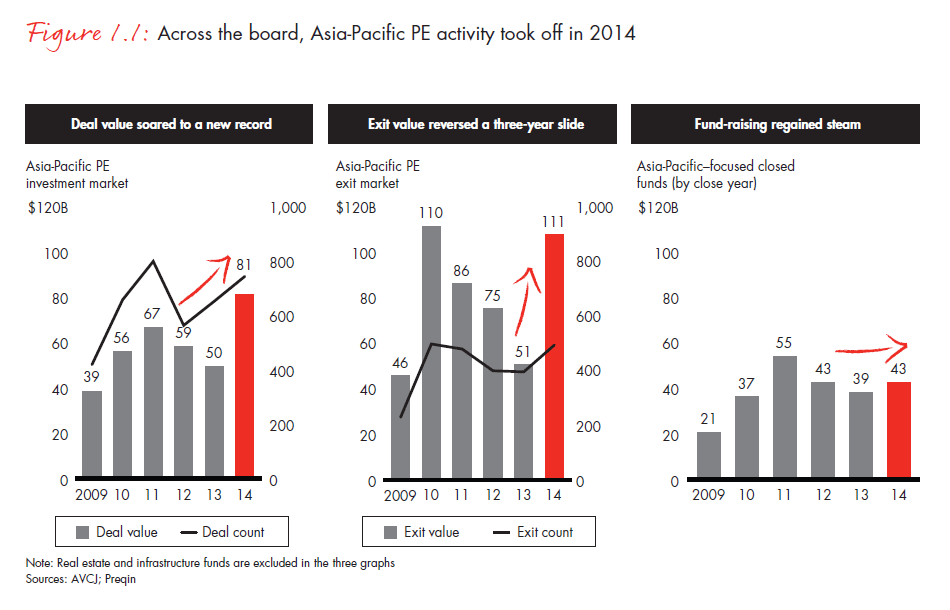
Since the slump began in 2011, we concluded that the recovery and long-term growth of the PE industry in the Asia-Pacific region will depend on two overarching factors: General partners (GPs) will have to find a way to return more capital to their investors and returns on investment will have to improve. The past year brought good news on both fronts.
The market hit a key milestone in early 2014 when investors—or limited partners (LPs)—became cash-flow positive in the region for the first time, meaning distributions are exceeding new capital calls, opening the door for new commitments. Median returns across the region also grew encouragingly, raising hopes for stronger results ahead.
This critical recycling of capital punctuated a year of standout performance among the PE firms doing business in the region, especially those in the top quartile. After three years of steep declines, exit value surged by 118% to a new all-time record of $111 billion, helping some GPs purge older companies lingering in their portfolios and allowing them to return a meaningful chunk of capital to LPs, which should help spur new fund-raising activity. The value of new investments, meanwhile, also soared to a new record of $81 billion, as firms found new ways to put piles of dry powder (capital raised but not yet invested) to work.
The obvious question following a period of such extreme volatility is whether the newfound momentum can continue. And there’s no doubt that will pose a challenge. On the deal side, rising asset prices and heavy competition will likely make it more difficult to close purchase transactions in the coming year, not less. Exit activity will depend heavily on continued strength in the region’s fickle equity markets. Much of 2014’s rebound in both deals and exits stemmed from a return of massive transactions involving the biggest and strongest PE firms—sometimes in partnership with large sovereign wealth funds (SWFs) or other LPs. Maintaining momentum in 2015 and beyond will likely require participation from a broader set of firms.
But for PE investors hoping to capitalize on the region’s robust long-term growth story, there is plenty to feel good about. GPs are making real progress in cleaning out a glut of uneconomic deals stemming from the surge of speculation that preceded the global financial crisis. They hold a record amount of dry powder and have ample motivation to spend it. New activity has demonstrated an important shift toward “path to control” mechanisms in minority deals, which give firms with minority stakes more ability to affect performance. And though a steady shakeout of weaker players is proceeding at a snail’s pace, the industry overall is getting stronger. More firms are learning how to compete in a PE market that rewards differentiated strategies and capabilities.
We’ve devoted Sections 3 and 4 of this report to an examination of what it will take for the industry to sustain its new momentum and what individual firms must do to retain the interest of an increasingly discerning group of LPs. The paradox of industry growth is that maturity makes it harder to generate superior returns, meaning firms will have to redouble efforts to squeeze more from their existing portfolios with robust value-creation plans and an activist approach to engaging with management. Overall, though, we are encouraged. While the Asia-Pacific PE industry will continue to experience some key challenges, 2015 should deliver important progress in laying a foundation for healthy, more sustainable growth.
2. What happened in 2014? A great year... for some
One of the notable aspects of the recent downturn in the Asia-Pacific PE market is that LPs never lost faith in the region’s growth story. Investors may have trimmed new allocations to the market as they waited for distributions to appear. But industry data shows they are eager to maintain exposure to a diverse set of economies with a history of strong economic growth and expanding legions of middle-class consumers. In 2014, the industry gave investors a taste of why their faith was warranted. But it also showed that the Asia-Pacific region is increasingly becoming a winner-take-all market.
Returns: Building momentum
It’s hard to overestimate the importance of LPs turning cash positive in 2014. Investors have enthusiastically pumped large amounts of capital into the region for more than a decade, only to be disappointed by anemic distributions and sliding average returns. As they became over-allocated in crucial markets such as China and India, they began to look elsewhere in the world with new capital, waiting for the Asia-Pacific market to catch up.
In the first half of 2014, that finally happened: LPs in Asia-Pacific funds got back almost $1.20 for each dollar called by GPs as PE firms locked in gains from older vintages and passed them back to investors (see Figure 2.1). Our data doesn’t include infrastructure or real estate funds because they tend to exist in their own orbit with a different set of dynamics. But if you were to include these two sectors, Asia-Pacific investors became cash flow positive in late 2013, an even stronger indicator of a consistent trend toward healthier distributions.
For LPs to keep making new commitments, however, it is equally crucial that those distributions come with improved returns. And that’s happening, too.
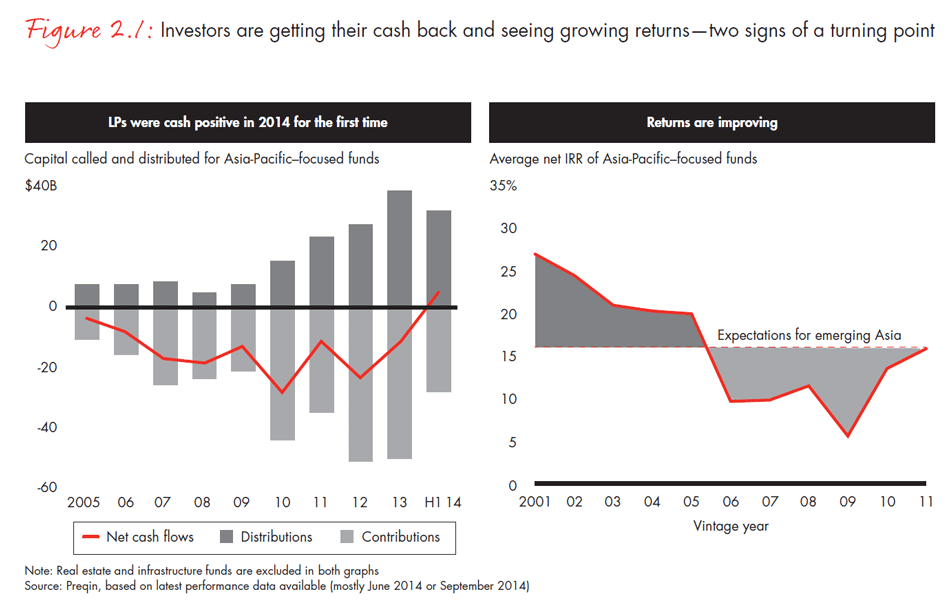
Older vintage funds in many cases have managed to surprise investors with better-than-expected returns over the past year. And while returns from younger vintages can fluctuate significantly over time, they are showing early promise. Median returns from 2011 vintage funds, still very young by PE standards, moved closer to the 16% net IRR that most LPs expect from their PE investment in the emerging Asia region. Top-quartile returns from the 2011 vintage pushed toward 23%. Even returns for the bottom quartile improved, signaling that the industry’s ongoing shakeout is helping shore up average returns from below. Overall, while the market’s median internal rate of return (IRR) still trails the off-the-charts performance of the pre-crisis period, the trend is positive. Median IRR rose from 9% to nearly 11% between late 2012 and June 2014, while returns for top-quartile funds hit 19%.
As encouraging as these signs are, however, sustaining growth will become increasingly challenging at the individual fund level. The days are gone when GPs could expect to easily find companies at attractive multiples and sell them three years later into a rising market. As we discuss in Sections 3 and 4, PE firms in a crowded Asia-Pacific region will have to be increasingly creative in how they generate returns. Data gathered by the Emerging Markets Private Equity Association (EMPEA) shows that investors have softened their expectations for the Asia-Pacific market somewhat as the industry matures and becomes more competitive. But they will continue to favor those GPs that can deliver consistent, above-market performance, making life that much more difficult for everyone else.
Exits: An IPO revival
After three years of steady declines, 2014’s surge in exit value was perhaps the year’s most encouraging development. It allowed PE funds in the Asia-Pacific region to exit investments worth $111 billion, more than double the value of 2013 exits and a touch higher than the previous all-time record of $110 billion in 2010. Exit value had bottomed out at $51 billion in 2013, when the Chinese government temporarily closed the nation’s renminbi-denominated IPO market to combat fraud. But the reopening of the Chinese IPO channel led to a 218% surge in exit value in Greater China (China, Hong Kong and Taiwan), owing in large part to the $25 billion Alibaba offering in September 2014 (see Figure 2.2). Even excluding that massive deal, overall exit value still rose 69% and the absolute number of exits jumped 25%.
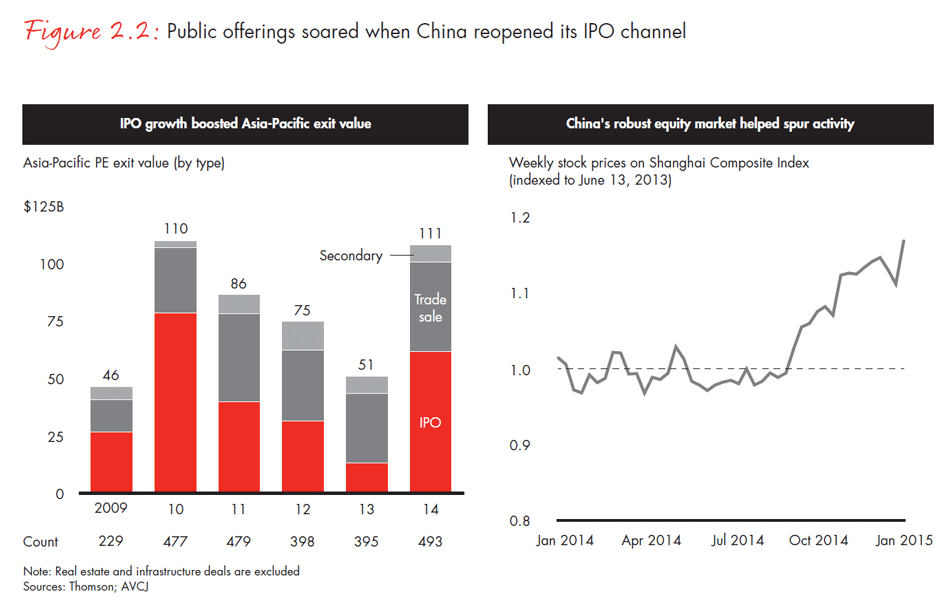
The sale of large assets—both IPOs and trade sales—also led to big double-digit percentage gains in South Korea, Japan and Australia. The second-biggest exit in the region last year was the $5.8 billion trade sale of South Korea’s Oriental Brewery to Anheuser-Busch InBev. The $3.5 billion trade sale of Arysta LifeScience gave a welcome boost to the total in Japan. The good news didn’t extend to the entire region, however. The total value of exits in India and Southeast Asia fell 10% and 9%, respectively. Deal count was relatively healthy, but neither market reaped the benefit of any large, market-moving exits.
The overall surge in exits regionwide has helped GPs begin to trim old deals from their portfolios. Although the total value of unrealized capital in PE funds rose 1% to a record $244 billion in 2014, it was almost flat for the first time since 2008, after five years of double-digit growth. Most important, it declined 14% for older vintage funds. The median holding period of companies in Asia-Pacific portfolios fell to 4.7 years in 2014 after six years of steady growth, another sign that GPs are succeeding in distributing more capital to investors and rebalancing their portfolios toward newer vintages.
Investments: A return to peak performance
At $81 billion, Asia-Pacific deal value set an all-time record in 2014, topping the previous mark of $77 billion set in 2007 (see Figure 2.3). The number of individual deals grew 14%, to 742, and average deal size increased to $110 million, from $77 million in 2013. Overall, the market experienced a robust 63% increase in total value compared with 2013 totals and beat the previous five-year average by 50%.
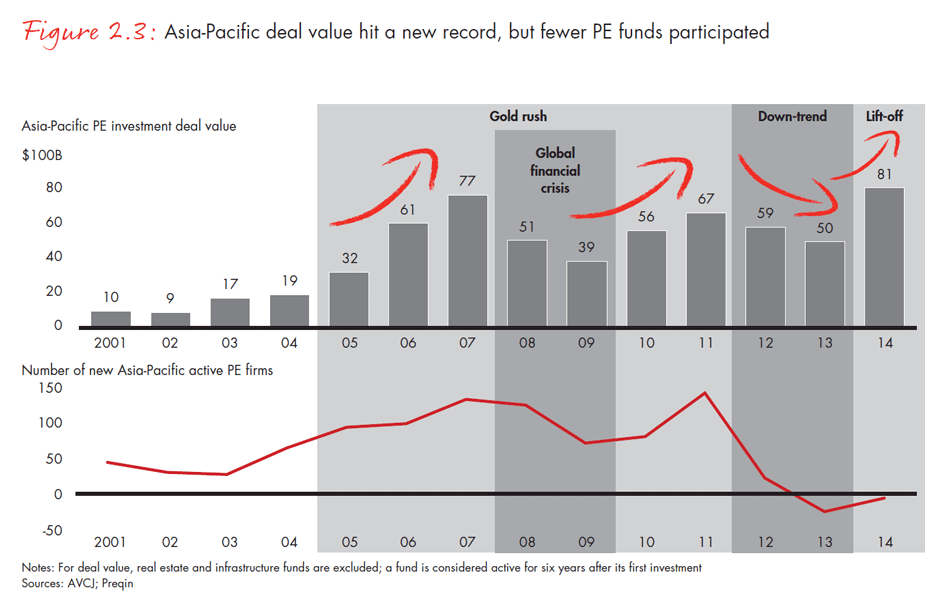
Once again, Greater China led the charge (see Figure 2.4). After a dismal year in 2013, the market enjoyed a surge in activity, spurred by a number of $1 billion-plus mega-deals. With the exception of Japan, each of the Asia-Pacific markets saw growth in deal value. But Greater China’s 182% increase, to $41 billion, dwarfed activity elsewhere in the region.
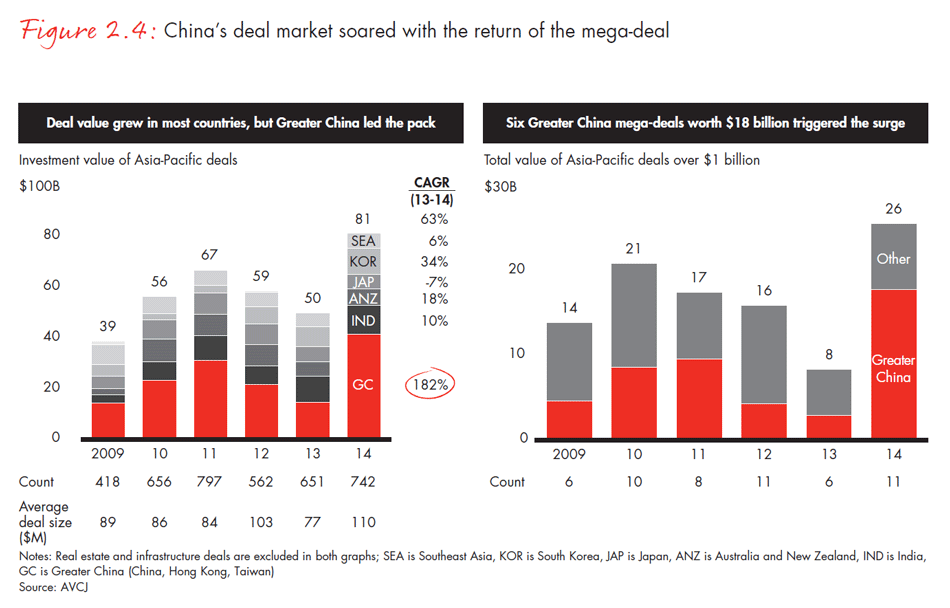
A major contributor to the overall value surge in the region was the reemergence of sovereign wealth funds as buyers. Temasek Holdings, the Singapore SWF, claimed the region’s biggest deal with a $5.7 billion investment in Hong Kong-based beauty retailer A.S. Watson Group. A Temasek-led investor group also paid $1.2 billion to buy an additional stake of agribusiness company Olam International in Singapore. Khazanah Nasional, the Malaysian SWF, helped fuel a $2.4 billion pre-IPO investment in China Huarong Asset Management.
It is important to note that only a select set of financial investors had the size and clout to address deals of this magnitude, suggesting it will be critical for participation to broaden to less massive players if momentum is to build over the long term. Still, in China, a surge in pre-IPO deals led to more activity among smaller funds and several local Chinese GPs found ways to tap deals that were previously only open to state-owned enterprises (SOEs). One prime example was a $5 billion investment in Sinopec led by RRJ, Hopu and other PE investors. Altogether there were six mega-deals in Greater China that topped $1 billion in value. Excluding those, China deal value would have still hit $23.7 billion in 2014, a 60% leap from 2013 and slightly higher than the market’s five-year average, (which includes mega-deals). The number of deals was about 30% higher than its historical five-year average.
As in recent years, growth and buyout deals drove the most activity throughout the region, with secondary deals— those between PE funds—accounting for about 20% of buyout value in 2014. GPs also renewed their focus on start-up and early-stage deals and the Internet sector drew the most interest overall. As we will discuss more fully in Section 3, GPs are paying much closer attention to ownership structure and governance, looking for creative ways to manage their risk by building path-to-control provisions into acquisition agreements.
Fund-raising: A clear flight to quality
After two consecutive years of declines, the Asia-Pacific region gained share in global fund-raising in 2014, as capital raised from LPs increased 11%, to $43 billion, while the global total fell 7%, to $375 billion (excluding real estate and infrastructure) (see Figure 2.5). As we’ve noted, that’s a clear testament to how much PE depends on recycling capital to thrive. What’s equally clear, however, is that LPs have become significantly more discerning about which funds get their capital. Having been disappointed during the last boom cycle, LPs are taking a much harder look at performance history and fund strategy this time around. The number of GPs closing funds in the region has declined steadily each year since 2011, and 2014 was no exception. But the total value of funds raised increased, because the average fund size jumped 51%, to $404 million. That reflects a growing preference among LPs to place larger amounts of capital with fewer proven winners.

Large buyout funds attracted the most new capital in 2014, and regional funds that offer LPs the protection of more diversification across the Asia-Pacific economies drew particular favor. Regional funds raised 33% more capital in 2014 than they did a year earlier and took home more than 50% of the total capital raised regionwide. Country-specific funds, meanwhile, raised 5% less capital.
About 250 funds were on the road looking for funds in 2014, but a decreasing percentage met their goals. Almost half of those seeking fresh capital in 2014 failed to reach their targets, and 40% are taking as long as two years to achieve final close. Experienced funds with more than $1 billion in assets under management continued to increase their share of total capital raised in the market, commanding 42% in 2014, about 20 percentage points more than in 2012 (see Figure 2.6).
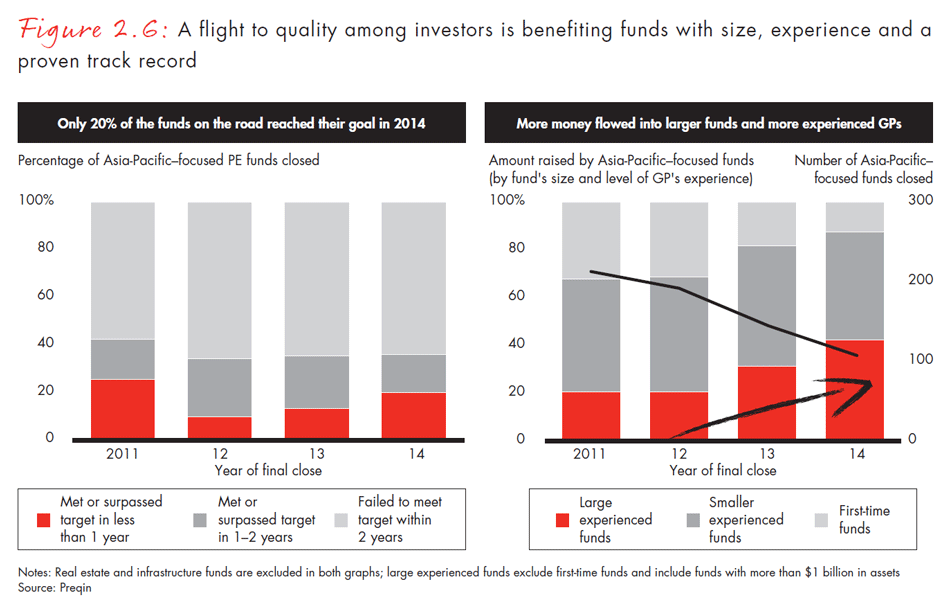
As we’ve said for several years, this bifurcation in fund-raising will have a beneficial effect on the market over time. The ongoing shakeout of the market’s worst performers should lead to healthier overall market performance. But by nature, PE funds can hold on for a long time, and the transition inevitably will be slow.
3. Outlook: What will it take to sustain momentum?
Given the roller-coaster ride the Asia-Pacific PE industry has experienced over the past several years, it is fair to ask whether 2014’s performance was anomalous or something more sustainable. Without a doubt, the Asia-Pacific growth story remains compelling even if the short-term outlook presents some macroeconomic and market-specific concerns. Amid slowdowns in China, Japan and Southeast Asia, the region’s overall growth in real GDP softened to 3.8% in 2014 from 4.3% a year earlier. But the Economist Intelligence Unit is projecting an increase to 4.4% in 2015, and few would dispute that the region’s long-term potential is intact. The Asia-Pacific region’s diverse set of economies stretching from China to Myanmar still outperforms the global average, powered by rapid development and modernization. Middle-class populations are exploding, and government policy is improving. Inflation and government debt are largely under control.
What’s been most crucial for the PE industry over the past several years, however, is that the region’s short-term slowdown in growth has reined in inflated expectations that led to a frenzy of sometimes unprofitable activity. LPs and GPs alike have recalibrated during the downturn and are approaching investment with significantly more discipline. Based on the evidence at hand, we’re encouraged that certain structural imbalances that have plagued the post-boom industry are easing and that a more mature industry is emerging. But we also recognize that several things must happen for the momentum to continue.
What we feel good about right now
We’ve already mentioned several of the most encouraging signs to emerge from the industry in 2014: LPs were cash positive in the Asia-Pacific region for the first time ever; strong exits should help GPs distribute more capital; and returns are on the rise, especially for top-tier funds. But there were a number of other important indications that PE in the region is transitioning from a market fueled by hopes and speculation to one rooted in strong, sustainable performance.
Healthier portfolios. One of the major issues GPs have faced in the wake of the pre-2008 boom period is that they bought too many companies at peak valuations with minority stakes, making it difficult to improve investment outcomes when performance soured. As economic growth slowed in the years following the boom, exiting these investments at acceptable returns became a challenge. As a result, GPs have tended to hold on to them, contributing significantly to the market’s large and growing exit overhang. Overall, unrealized value in Asia-Pacific portfolios grew 30% annually from 2009 to 2013, ultimately reaching $242 billion.
But the situation is improving steadily. As exit activity picked up in 2014, growth in unrealized value slowed to 1%. That’s because many GPs were able to pare away at their exposure to the oldest transactions. Looking at buyout deals alone, investments bought from 2005 to 2008 made up 23% of the total value from unrealized and partly realized investments in mid-2014, down from 33% the year before and far below the 44% global figure (see Figure 3.1). Additionally, the median holding period of Asia-Pacific investments declined to 4.7 years, the first such decrease since 2007.
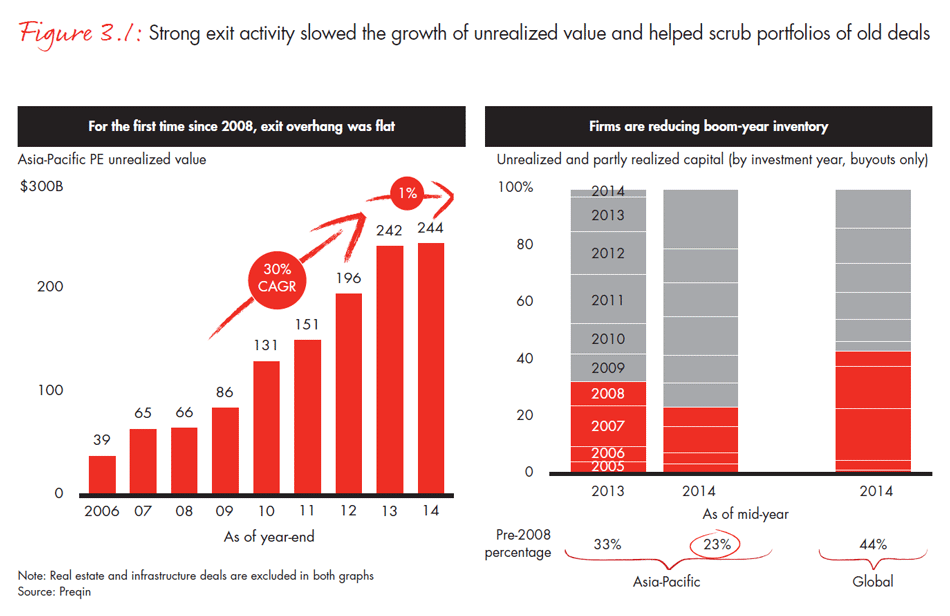
A push for more control. As GPs whittle down their exposure to older, less attractive deals, they also are taking important steps to secure meaningful ways to add value to their portfolio companies in the future. Minority-stake deals are still most prevalent in the Asia-Pacific region (up to 90% of deal count in some markets). But in our survey, about 60% of the Asia-Pacific GPs and almost 70% of the funds focusing on Southeast Asia, South Korea and Greater China said they are seeking path-to-control mechanisms in these transactions so they can participate more fully in value-creation strategies and decision making (see Figure 3.2). The most popular provisions include board seats and veto authority over key decisions involving people, capital spending and M&A activity. GPs estimate that over the past two to three years, a healthy 30% of the minority deals they’ve entered had paths to control. And they believe the opportunity exists to boost that number closer to 40% over the next few years.
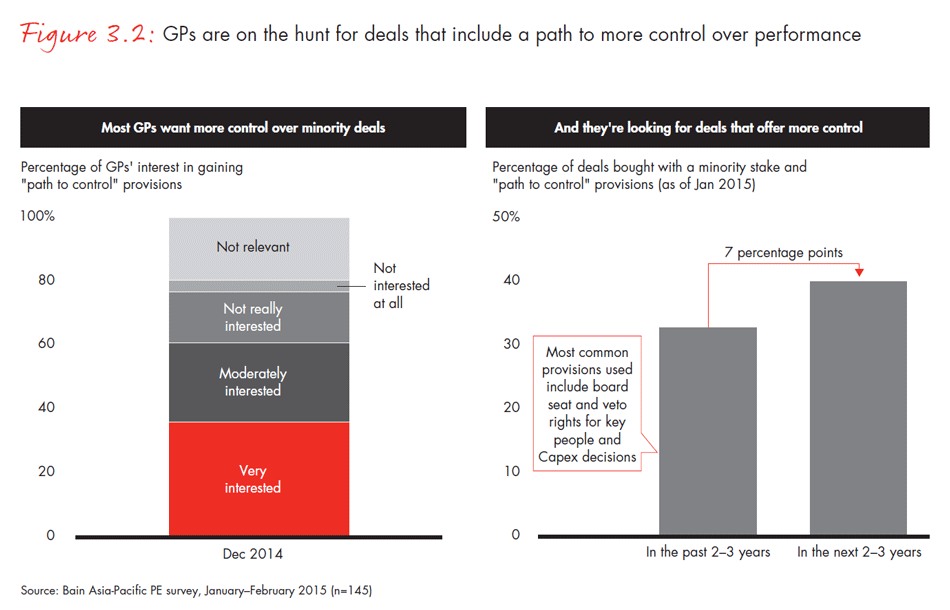
Fewer, but stronger, GPs. As we’ve said, the shakeout in the Asia-Pacific PE market has been under way for several years, and that means fewer underperforming funds are on the market, either seeking new capital or competing for a finite pool of deals. In 2011, money-losing funds made up almost half of the total fund value on the market. In 2014, that number dropped to 15%. Over the same period, top-performing funds—those earning better than 16% on average—have moved to 21% of total value, from 11%. And as the stronger funds get even stronger, they attract the most new capital, perpetuating a virtuous cycle that is creating a more healthy, dynamic pool of funds overall (see Figure 3.3).
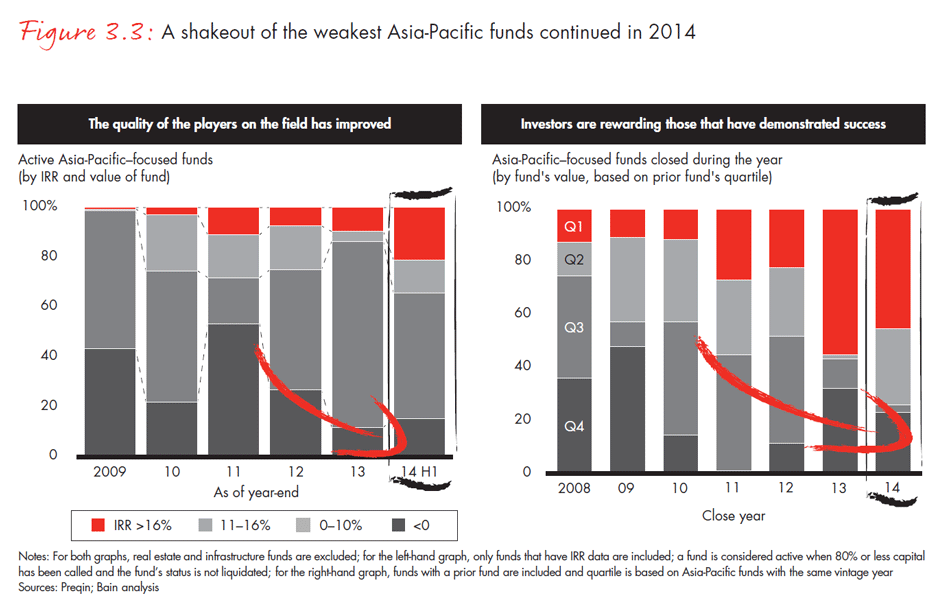
Our optimism in this area, however, stems more from the trend than the immediate impact. There are still more than a thousand PE firms operating in the Asia-Pacific market, and many are struggling. The long-term nature of the business means it can take years for troubled funds to unwind and exit the market completely. It’s also important to note that remaining among the top performers is becoming increasingly difficult. Historically in the PE industry, past performance has been a reasonably reliable indicator of future returns for LPs figuring out where to put their money. But as we observe in our Global Private Equity Report 2015, that’s less true than it used to be. It is becoming harder for GPs to produce market-beating returns year after year. The shakeout of poor performers is real, and we’re confident that is building a firmer foundation for future industry growth. But we’re equally certain that future performance by individual funds will require a higher level of execution across every link in the investment value chain.
More opportunity. Despite many years of strong activity, PE is still significantly underpenetrated in the Asia-Pacific region relative to the rest of the world. Private companies that could benefit from PE investment are plentiful— especially in markets where other sources of capital are scarce. But in the past, many company owners have been reluctant to trust outsiders with an equity stake. Now that is changing. In recent years, owners throughout the region have become more and more comfortable with taking on PE firms as trusted partners, opening more opportunities for GPs to gain access to proprietary deals or negotiate greater control over decision making. As the industry matures, the number of PE-backed assets is also increasing, which creates more opportunities for already popular secondary deals—those where PE firms are both the buyer and the seller.
Strong investor commitment. Given the Asia-Pacific region’s volatility in recent years, LPs have remained remarkably committed. The region’s growth profile is a magnet for investors looking for emerging market diversification, and PE offers a lucrative way to capitalize. Even as returns slumped in the Asia-Pacific region following the global economic crisis, the PE asset class still outperformed many other investment options. Buyout investments have returned more than public markets in the Asia-Pacific region over both short- and long-term horizons. Globally, LPs have become under-allocated in the PE asset class (based on their stated targets), and in the 2015 Preqin Global Private Equity and Venture Capital Report, 84% said they plan to increase or maintain their investment. More also plan to devote a larger share of their PE allocation to emerging markets. In 2014, 35% of the LPs surveyed by EMPEA said emerging market funds made up 16% or more of their total PE allocation. But 47% said they wanted to push above 16% by 2016.
Bullishness on the ground. The GPs in our survey unanimously said they expect at least a slight increase in deal activity in 2015. That’s probably not surprising given the record $132 billion in dry powder sitting in Asia-Pacific portfolios (see Figure 3.4). A full 83% of GPs said that making new investments would be the firm’s first or second priority in 2015 (see Figure 3.5). That means that even if competition and rising asset prices provide headwinds, GPs will be pushing harder than ever to find ways to make more deals happen.
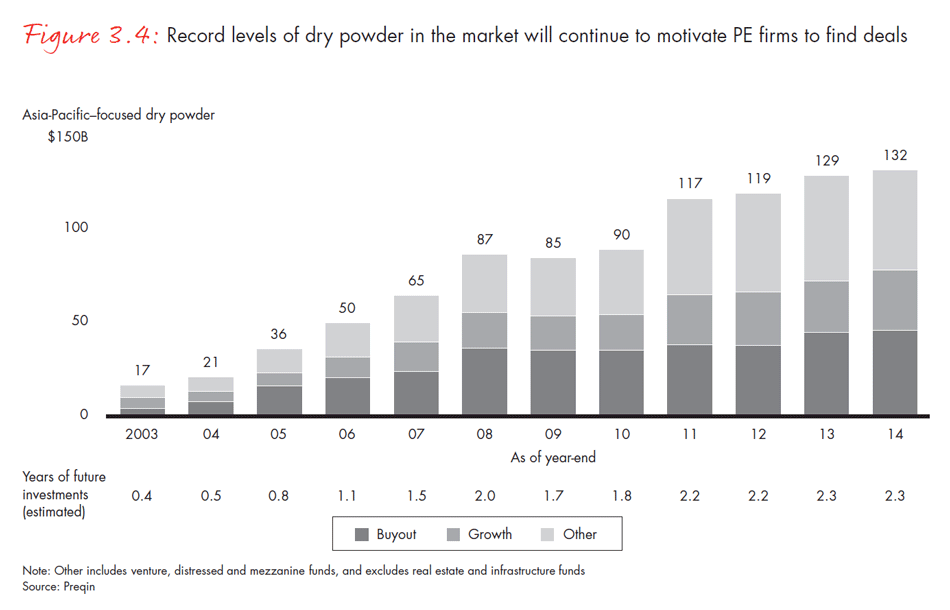
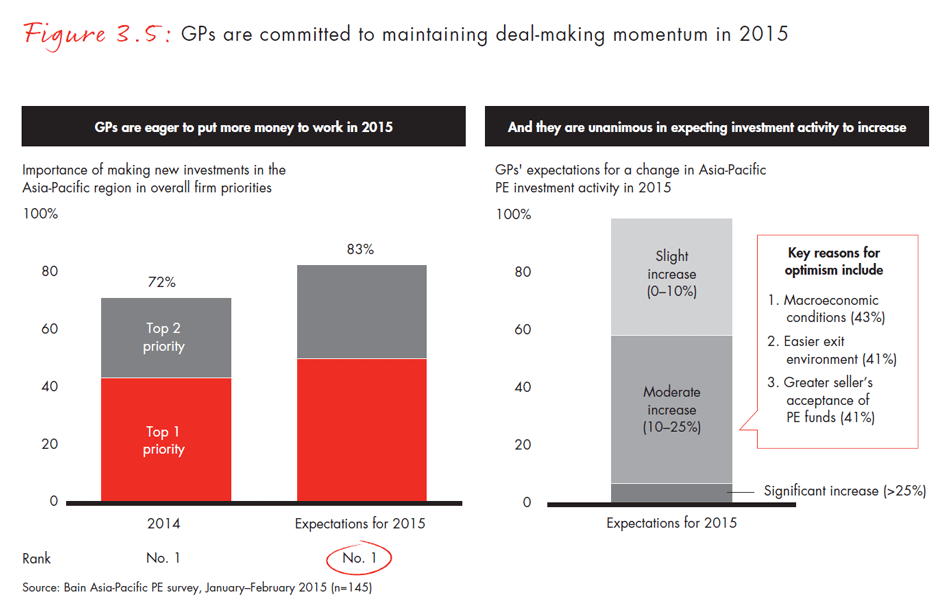
Areas of concern
While each of these factors bodes well for the future, several areas of concern remain. The Asia-Pacific PE industry is still working through a multiyear transition toward more reliable performance. If LPs are to maintain their enthusiasm for the PE asset class, they will need to see a steady flow of healthy capital distributions and evidence that improving returns on investment are sustainable. For that to happen, GPs will have to push harder to put more money to work and extract more value from their portfolios. Here’s what we’re looking for:
A renewed push for performance. Although average returns have improved substantially from their nadir in 2009, the gap between the best and the worst funds also has narrowed (see Figure 3.6). On the one hand, this is encouraging evidence that the worst performers are dropping out of the market as LPs shift new capital to the best performers. But it also suggests that making money at the top end has become significantly more challenging as the industry matures and becomes more competitive.
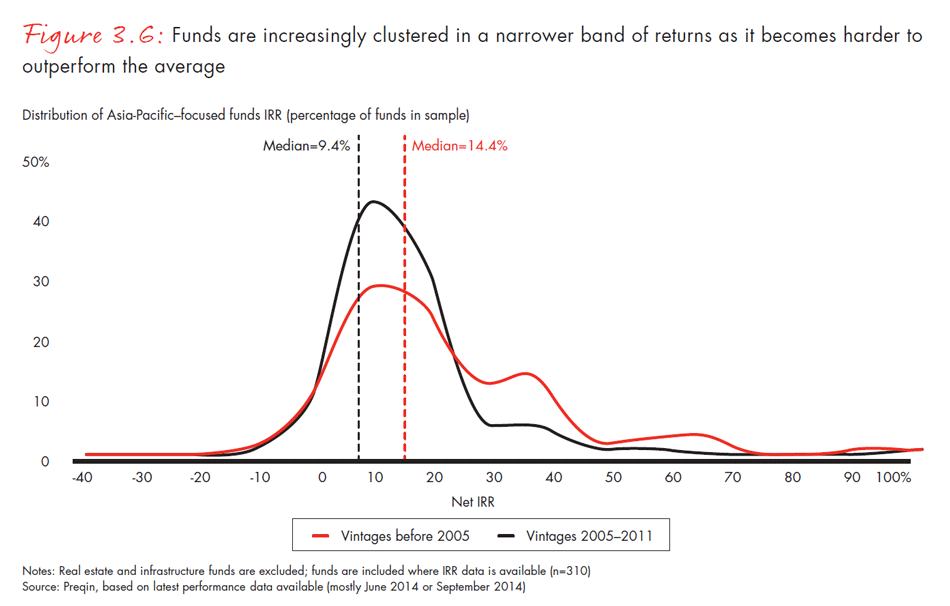
Before the global financial crisis, GPs in the Asia-Pacific region could count on buying companies at reasonable prices and watching their multiples expand alongside rapid GDP growth. “Quick flips” of three years or shorter were common, helping produce world-beating returns that attracted floods of new capital. But those easy-money days are over. GDP growth in large, maturing markets like China has slowed and in a world of superabundant capital, it has become increasingly difficult for even the best GPs to string together year after year of superior results. That is as true in North America or in Europe as it is in the maturing markets of the Asia-Pacific region.
Lots of money in many hands has a democratizing effect. It tends to level out performance across a given market. Crowds of potential buyers make it considerably harder for top firms to ferret out proprietary deals at cheap prices. Instead, auctions drive up asset values, which forces GPs to hold companies longer and work harder to create value via cost-cutting, new product strategies, M&A or other mechanisms. Price multiples have been growing in the Asia-Pacific region, and although the market’s median holding period for assets declined to 4.7 years in 2014, that’s still significantly higher than in earlier years. The absence of quick flips makes it harder for GPs to meet investor expectations (see Figure 3.7). The combination of all these factors acts as ballast for even the best-run portfolios.
Most of the Asia-Pacific GPs we surveyed don’t anticipate a drop in asset prices, and few believe that the median holding period will improve meaningfully in 2015. More than half of those experiencing moderate or significant issues with older vintage companies said they would rather wait for a better time to exit than sell at a discount or write off the investment.
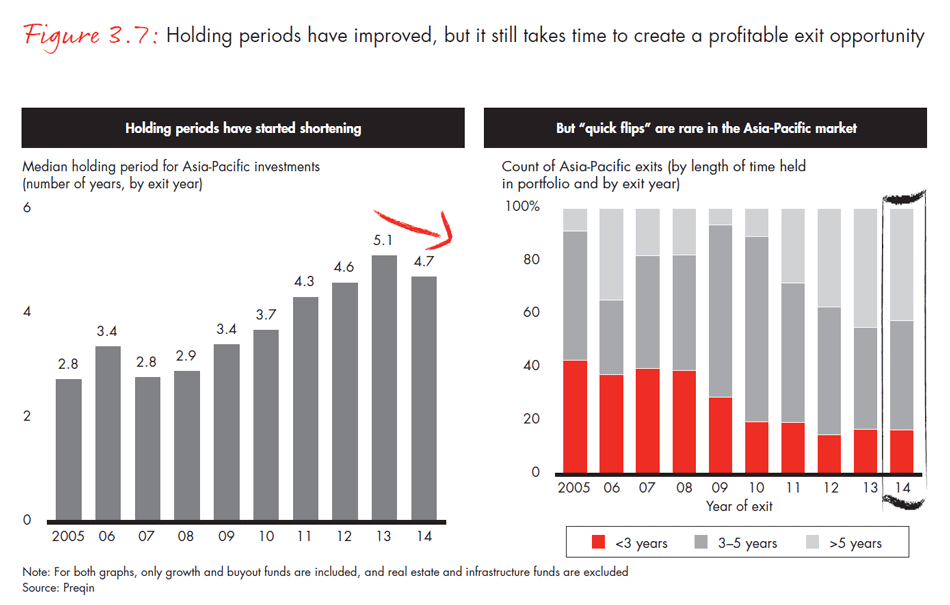
As we’ve noted, returns from younger vintage funds show strong improvement, which is an important cause for optimism about the sustainability of IRR growth. But it is also hard to draw too many conclusions. Returns from younger vintages reflect largely unrealized gains, making it difficult to predict how returns will actually unfold in the future. Unsold assets sitting in a fund portfolio can have dramatic impact on its performance over time. Our analysis demonstrates that it is not until around year seven that the returns truly prove out (see Figure 3.8).
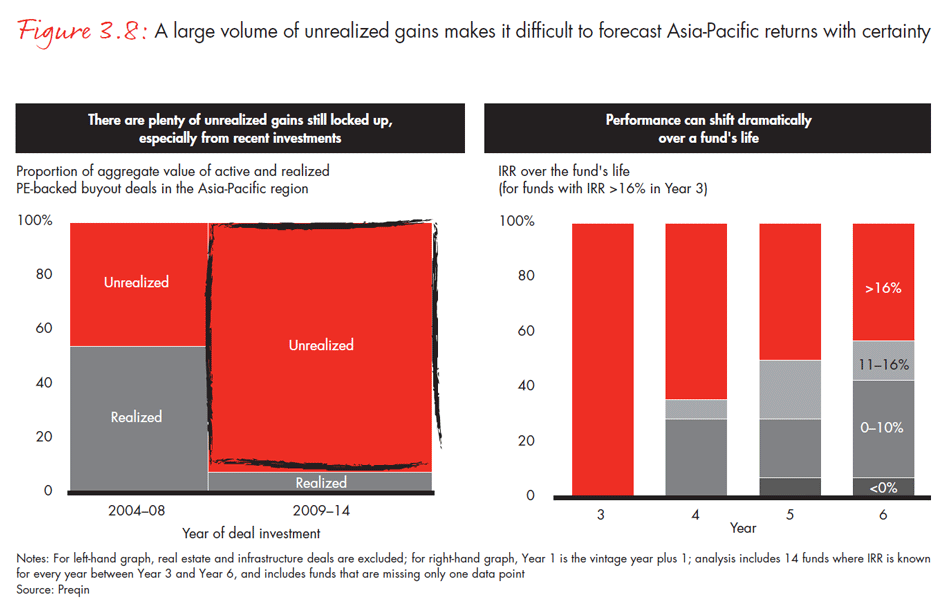
All of this points to a single important conclusion: GPs will have to work harder and more creatively if they are to meet investor expectations in the future. They will clearly have to double down on efforts to work through the glut of pre-2009 vintage investments weighing down their portfolios. But as we discuss more fully in Section 4 of this report, GPs will also have to step up to a new level of portfolio activism.
Sustained exit momentum. Maintaining exit momentum will be one of the most important challenges in the coming year. And success will depend heavily on the health of the volatile IPO channel. IPO deals—most notably the $25 billion Alibaba blockbuster in China—were responsible for well over half of all Asia-Pacific exit value last year. Continued momentum will likely hinge on the degree of equity market volatility, especially in Greater China, Japan and Australia, which have accounted for 90% of the region’s IPO value and more than 80% of transaction volume over the past five years. All three markets had strong exit volume in 2014, supported by high public valuations and GPs eager to pare down large exit overhangs so they could attract new capital. GPs will be no less enthusiastic in 2015. But, as always, predicting the direction of equity markets is tricky.
The good news on the exit front is that the outlook is strong for trade sales, which have accounted for about 40% of the total exit value and almost half of the deal volume over the last five years. Corporate buyers with a surfeit of cash have been active in the market for several years, looking to meet ambitious growth targets with acquisitions. In markets where these strategic buyers have less-than-perfect visibility, they often view PE ownership as a stamp of approval, assuming that GPs have worked hard to polish and de-risk their portfolio companies. Secondary sales— or transactions between two PE funds—should also provide some opportunity. These marriages of convenience slipped in number last year amid the surge in IPO and trade deals. But volume was on par with the average over the past five years and should increase over time. GPs often find that secondary exits are quicker to arrange and have a higher chance of completion than trade sales or IPOs. With PE funds feeling pressure to put capital to work and return cash to their investors, these deals also can provide a compelling alternative to both parties.
Manageable competition and pricing. With the world awash in cheap capital and buyers of all types on the hunt for investments, it is unlikely that global competition for deals will ease anytime soon. In the Asia-Pacific region, where $132 billion of available dry powder is representing 2.3 years of future investment, there is still a lot of money chasing a limited number of deals (see Figure 3.9). According to Bain’s Asia-Pacific survey, most GPs believe competition will increase on all fronts in the coming year. But they are particularly wary of pressure from regional and local GPs, as well as from cash-rich corporate buyers, all of which tend to show up as potential suitors for any attractive company. LPs hoping to enhance their returns may also inject more “shadow capital” into an already saturated market, although only a small group of LPs currently have the capabilities to source and execute standalone deals. According to our survey, GPs expect to see more co-investments.
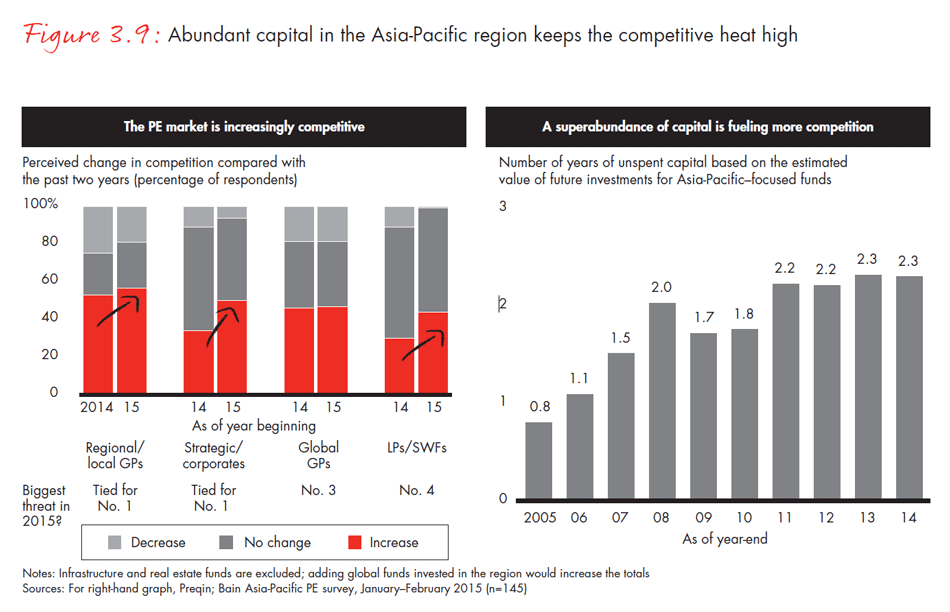
Increasingly intense competition, of course, pushes asset prices higher, making it more difficult to find and justify suitable investments. It doesn’t help that robust equity markets in various Asia-Pacific markets also have tended to support higher multiples. If that fueled the surge in exit activity last year by lifting the IPO markets, it also emboldened sellers to demand higher prices—a trend that, if it were to continue unabated, could dampen deal making. All told, the average multiple of enterprise value to EBITDA for Asia-Pacific PE-backed transactions last year was 15.3. This was up 21% from 2013 and was 59% higher than the 9.6 average multiple in the US market registered for buyouts only, in the first half of 2014 (see Figure 3.10).
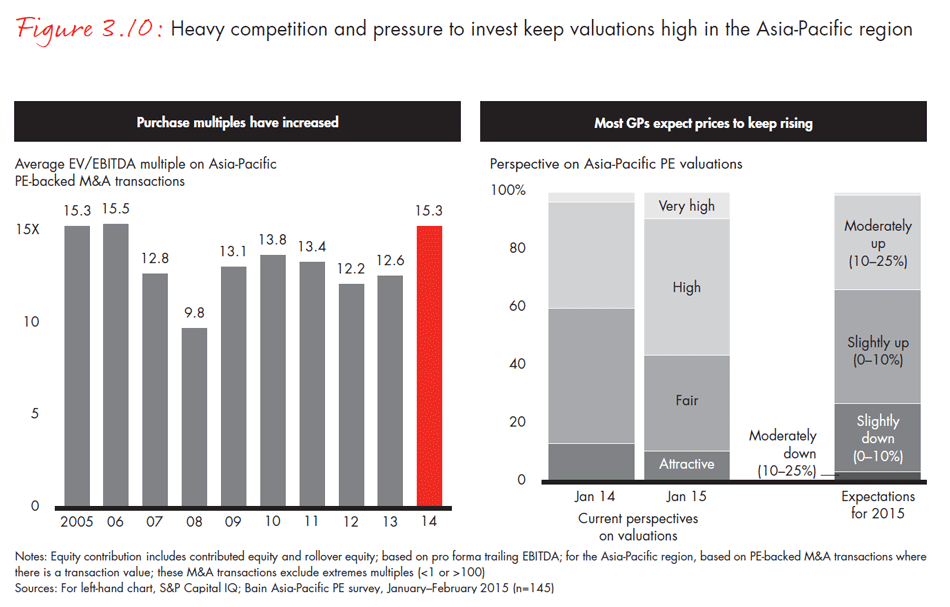
Not surprisingly, an increasing proportion of the GPs in our survey consider current valuations in the Asia-Pacific market high to very high, and 72% of them expect prices to continue climbing to some degree in 2015. The ongoing shakeout among GPs may help to ease pricing over time. But given the competitive pressures and superabundant capital, valuations will remain under pressure. Record dry powder means GPs will be motivated to do deals even if faced with higher multiples and stiff competition. The challenge will be to avoid past mistakes by seeking out proprietary opportunities, securing path-to-control mechanisms and devising an exit strategy from day one.
Stable geopolitical and macroeconomic conditions. As we’ve seen time and again in the Asia-Pacific region and other emerging markets, economic and political volatility can have outsized effects on investment activity. In 2014, for instance, activity in both India and Indonesia slowed in the months before key elections as investors waited to see who would win and how it would affect those markets. In “Diverse markets, diverse outlooks,” below, we take a closer look at what to expect from each of the Asia-Pacific markets in the coming year. Perhaps most worrisome is that the deceleration of China’s economy, which Bain anticipated several years ago, has moved into full swing. Growth has followed a highly volatile but downward trend from roughly 10% at the beginning of the decade to just 6.6% (annualized quarter vs. quarter) since the beginning of 2014. Given long-term population and productivity trends, Bain expects the slowing to continue at a moderate pace through the end of the decade. This will likely produce ripple effects throughout the region, especially in markets like Australia, which relies heavily on exports to China.
Despite the turnaround in Asia-Pacific PE, these challenges underscore that it will be no easier to find deals, close them and generate superior returns. LPs may have increased their allocations to the region this year, but they continue to whittle down the list of firms they will back, favoring only those that can truly differentiate themselves and demonstrate consistent performance. As we discuss in the final section of this report, GPs have the opportunity to create their own future in the Asia-Pacific region by focusing hard on creating more value from their portfolios. Those firms that can’t state precisely what they stand for and how they will outperform the averages are likely to struggle against firms with a sharply differentiated strategy for consistently delivering value.
4. Taking a more active role in winning
As kind as 2014 was to many Asia-Pacific PE firms, it’s also clear that the table stakes in the region continue to rise. Slower economic growth, stiffer competition and higher multiples will only make it harder to generate market-beating returns in the future. And as LPs narrow their bets to fewer firms at the top end, underperformers will be starved for new capital, making it increasingly difficult to stay in the game.
Before the global financial crises, when investment capital was flooding into the Asia-Pacific region almost indiscriminately, success was sometimes a simple matter of putting as much money to work as possible. The rapidly rising economic tide tended to lift all boats, and PE firms could ride steadily expanding multiples to extraordinary returns. But those days are long gone. While GDP growth and interest rate dynamics still have a powerful effect on multiples, GPs today understand that they can no longer count on economic forces alone to boost the value of their portfolio companies. Winning requires elevating their performance across every link of the investment value chain, which often means going back to the basics: creating a differentiated strategy for generating sustainable performance and taking an active role in molding portfolio companies into winners.
The power of portfolio activism
If the downturn taught the industry anything, it is that lasting value comes from active engagement with portfolio companies. An activist approach is just one part of a value chain that also includes proactive deal sourcing, effective due diligence and a well-planned exit strategy. But it is a critical one, especially in the Asia-Pacific region, where so many deals have historically involved minority stakes. In many cases, Asia-Pacific GPs have had their hands tied when it came to affecting decision making, operations and investment. That has forced them to write off some investments and hold onto others for longer than they’d hoped, resulting in downward pressure on investment returns.
Part of the problem is that the game has changed. Before the global financial crisis, GDP growth, multiple expansion and leverage (when it was used) had the biggest impact on returns. Today, it’s mostly about profit growth, survey respondents said. With valuations already elevated, buying low and selling high is no longer the go-to deal thesis. And in most countries, where interest rates have nowhere to go but up, it is more difficult to count on leverage to magnify returns. Growth across this diverse set of economies is still robust, but it is moderating as markets mature, limiting top-line potential. Cost savings help improve results when revenues are slow, but those opportunities are often baked into the prices paid for assets.
With all these forces in play, the highest-performing GPs are rolling up their sleeves and getting directly involved in their portfolio companies. They are making full use of operational changes, talent selection, M&A and capital efficiency to increase bottom-line performance. A “good buy” is still a prerequisite for any successful deal. But generating market-beating returns increasingly means turning good buys into great ones and, occasionally, finding ways to salvage mistakes.
That’s why path-to-control mechanisms can become a real asset for many GPs in the Asia-Pacific region. Growth deals with minority stakes still dominate in many of these markets. But, as sellers warm up to the PE value proposition, they are more and more open to giving GPs the board seats and decision rights that firms can use to influence a company’s direction and meaningfully contribute to value creation. We view the expansion of these provisions as a crucial market development. But it is also important to note that paths to control are no panacea. What ultimately determines value is how well GPs make use of them to improve the performance of portfolio companies.
Most GPs in the region are mobilizing to develop the internal talent and capabilities needed to support portfolio activism. Our survey indicates that the median fund in the Asia-Pacific region currently has two to three full-time employees devoted to value creation, a number that should almost double over the next three to five years (see Figure 4.1). Almost 90% of firms say that, within the first six months of ownership, they develop a robust value-creation plan for at least half of their portfolio companies. Around 75% are doing deep dives with company management to identify potential sources of value and devise means to extract it.
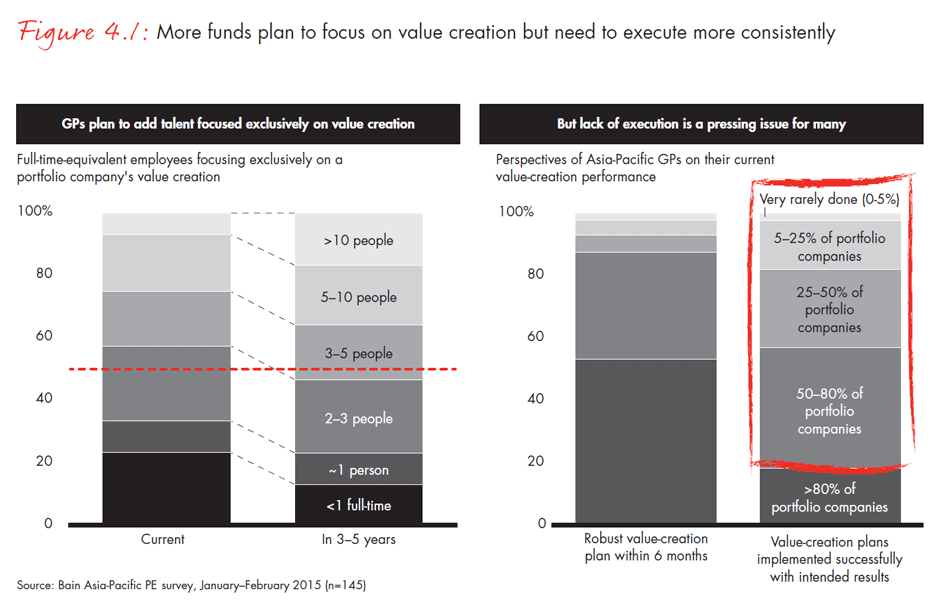
Most often, the problem is execution. Only 18% of those GPs in our survey report that their value-creation plans deliver the intended results. Few firms systematically engage with each company in their portfolio, and still fewer do it consistently well. This isn’t just an Asia-Pacific problem. A Bain survey conducted through the Private Equity Operating Partner Executive Network (PE OPEN), a global network of more than 400 partners responsible for portfolio company oversight, found that while more than half of the respondents reported that their firms have a clearly defined operating model to create value in their portfolio, fewer than 5% apply the model consistently with each portfolio company they own and with the depth and quality intended.
This isn’t particularly surprising. It is always hard for PE firms and company management teams to pivot cleanly from the intensity of the deal-making process to the heavy lifting of improving performance. Complacency, a reluctance to raise difficult issues and confusion over roles all can deter quick action. Many GPs in the Asia-Pacific region are also in the early stages of building out teams on the ground, making it difficult to achieve higher levels of execution. The ultracompetitive nature of these markets—and the record overhang of unrealized capital from the boom years—means firms are under intense pressure to find deals, put money to work, craft exit strategies and pay back impatient investors. Often there is simply not enough time or bandwidth to accomplish all that needs to get done.
Firms are taking different approaches to solving the problem. KKR in the Asia-Pacific region, for instance, is hiring a number of ex-consultants to build in-house teams that can consult with company management, supported by many junior analysts and a few senior people. Alternatively, the Carlyle Group and Olympus Capital have assembled groups of former senior executives of blue-chip companies, who can provide invaluable advice to portfolio CEOs. In between, Temasek, GIC and Barings have built teams of people with a combination of consulting and industry experience.
There is no right answer for how to structure a team devoted to portfolio activism. In Bain’s experience, however, all effective activist value-creation programs feature five critical building blocks. None is sufficient on its own, but we find that the firms that deploy these building blocks early and throughout the asset’s hold period generate more value and are more likely to produce consistent, market-beating returns.
1. Harvest low-hanging fruit quickly. Every deal presents opportunities for quick fixes. Tweaking pricing or boosting salesforce effectiveness can increase revenues right away. Smarter procurement, better inventory management or asset rationalization can cut costs and improve margins. Very often, effective due diligence identifies opportunities like these, and it is important to engage with management to take advantage of them quickly. Even if some of this upside was already reflected in the purchase price, aggressive action can take some of the risk out of the investment in year one, while building early momentum and credibility with management. The mistake many managers make is celebrating early. It’s easy to believe that these quick measures alone constitute a value-creation plan. To fight off this sort of complacency, firms need to emphasize that this initial cleanup phase is only the beginning of a longer-term effort to improve performance.
2. Design a robust value-creation plan in year one. An essential parallel step is to devise a longer-term strategy that can guide value-creation efforts. The best activist firms recognize that time is of the essence and step in immediately to help management assess the company’s full potential and then develop an aggressive plan to get there. When launched early and formulated jointly with the portfolio company’s management team, a strong value-creation blueprint can have a huge impact on deal success. A study of 128 deals where Bain worked with management post-acquisition showed that rolling out such a plan in the first year of ownership produced a multiple of 3.6 times invested capital—twice the industry average. We believe the reason these plans are so effective is that they focus efforts on the right priorities, assign proper resources and secure strong alignment between the PE fund and company management around specific, tangible goals. The best of them start with a clear view of where the business stands today and a bold vision of its long-term potential. They then take a long wish list of initiatives and whittle them down to the three to five that have the best chance of moving the needle within the firm’s preferred five-year investment time horizon.
3. Execute on what matters most. The best value-creation plans, of course, are only as good as their execution. And to some degree, execution depends on how much control a PE firm has over key decisions and strategic moves. To the fullest extent possible, the best portfolio activists translate the three to five key initiatives laid out in the value-creation plan into a clear, actionable roadmap for reaching a specified level of equity value. The plan often sets up a program management office to oversee execution and defines the key metrics used to both track performance against the plan and to provide early warnings about what’s not working. It is crucial, however, that the PE firm and management revisit and refresh their value-creation strategy at regular intervals and adjust appropriately to account for changing competitive or market dynamics. It can’t be a static document. When it’s time to exit, the firm can use the value-creation plan to build the economic case for the asset’s sale and to identify future growth opportunities for the next owner.
4. Deepen the talent pool and build a high-performance organization. Many GPs will tell you that grooming a portfolio company’s management team—or putting in a new one—may be the most important factor in any deal’s success. In a recent survey by accounting firm Grant Thornton, PE executives ranked management team ahead of strategy, operational improvements or macroeconomic factors as the most important element influencing their portfolio companies’ results. Yet Bain has found that 85% of the companies in a typical fund have organizational issues that significantly inhibit success. About half the time, according to our latest research, PE firms are forced to change a company’s CEO over the period of ownership. In three-fifths of those cases, the ouster was unplanned.
This kind of management turmoil can disrupt even the best-laid value-creation plans. So it is essential to put the right team in place as quickly as possible and then give it full support with strong incentives to succeed. The best-performing PE firms undertake an early and clear evaluation of the CEO and the top team. They translate the value-creation plan into “big jobs” and make sure to fill them with “big people.” They then align the rest of the organization to the value-creation plan and identify ways to overcome key execution risks. This process inevitably identifies talent gaps, which must be filled quickly. And since talent placement is an imperfect science, experienced firms are constantly anticipating the need for change. When problems arise—from the CEO on down—they are prepared to take swift and decisive action by drawing from a stable of seasoned senior executives who can be parachuted in to fill key management roles.
5. Overinvest in good deals to convert them into great ones. Top performers in the Asia-Pacific region and elsewhere around the world share a key trait: They are reluctant to throw good money after bad. All firms make mistakes in picking companies and have to contend with deals gone sour. But the best ones resist the temptation to devote management time and resources to trying to fix every loser in their portfolio at the expense of nurturing their winners. The simple fact is that the average fund can gain much more from turning a good company into a great one than from trying to rescue a bad one. A Bain study that simulated alternative outcomes for a set of funds from vintage years 1995 to 2007 found that investing to go from good to great has three times greater impact than trying to lift a money-losing investment marginally above breakeven.
The irony is that “good” companies tend to get less attention from PE management because they are generally on track. That leaves underperformers to soak up scarce time and resources. Firms responding to the PE OPEN survey said they devote, on average, 40% of portfolio resources to deals promising less than two times their invested capital. Some said they are expending as much as 60% to turn around deals that won’t likely return their cost of capital. Most funds simply can’t afford that kind of inefficiency, especially in the Asia-Pacific region, where talent on the ground is limited and leadership constantly needs to make trade-offs to address new challenges. Eventually every portfolio sorts itself into the losers and winners. The best GPs have the discipline to redirect resources from one to the other, boosting their overall portfolio performance in the bargain.
Identifying barriers to value creation: A self-assessment
Bain’s Global Private Equity Report 2015 pointed out that the most successful PE firms around the world share another trait: They quickly transition from thinking like acquirers to acting like value creators. Before the ink has dried on the deal contracts, they are mobilizing with company management to draft a value-creation plan and put it into motion. For PE firms in the Asia-Pacific region, this is a particularly daunting challenge. Aging portfolios, a persistent overhang of dry powder and unrealized capital, and volatile exit markets each steal time that fund management might otherwise devote to working with the most promising portfolio companies to help improve them. What follows is a set of questions designed to help these firms evaluate whether they are devoting enough time to these five building blocks. They also will help firms consider how they might adjust their priorities to build more sustainable performance.
- Has your firm developed Repeatable Models® for creating value in portfolio companies, and does it have the commitment of the deal partners?
- Does your firm have formal processes in place—endorsed by senior partners—that enable it to pivot quickly from deal making to value creation as soon as a deal closes?
- At each of your portfolio companies, are management and operating partners aligned on the short list of priority initiatives that will really move the needle on equity value creation?
- Has your firm built a network of C-level executives it can call upon to manage a portfolio company as the need arises?
- Is there consensus among your deal and operating partners about which portfolio companies have potential to go from good to great, and does your firm back those companies with sufficient resources to help them become big winners?
- Does your firm conduct periodic reviews of each portfolio company and adjust both near-term and long-term objectives to accommodate changing macroeconomic conditions, new portfolio company challenges and opportunities, and shifting industry dynamics?
Diverse markets, diverse outlooks
Spanning from India to Japan and from China to Australia, the Asia-Pacific region is nothing if not diverse. While 2014 was a spectacular year for the region overall, clear differences appeared across geographies. Below is Bain’s perspective on what happened in each of these markets over the past year, and on what to expect in 2015 and beyond.
Greater China: Breakout activity... but for how long?
The Asia-Pacific region’s biggest market roared back to life in 2014 as deal value reached $41 billion, a full 33% higher than the market’s previous peak in 2011.While six mega-deals larger than $1 billion accounted for most of the investment growth, GPs worked hard to put capital to work, pushing the number of individual transactions to 350, 30% higher than the market’s five-year average. Exit value also exploded behind Alibaba’s $25 billion IPO, surging to $61 billion, more than triple 2013’s value. Both pre-IPO deals and exits benefited from strong equity markets and got a major boost from the reopening of China’s IPO channel following its closure from late 2012 through 2013.On the buy side, Internet deals soared, contributing about 40% of the total volume, compared with about 15% for the last five years. Technology and healthcare also did well. A number of key developments indicate China’s market is undergoing an important transition. The return to the market of sovereign wealth funds—most of them foreign—led to many of the market’s largest deals. And a few local GPs with access to proprietary deal flow and patient state-backed capital sources continued to be important players. Although growth deals still make up the bulk of the market, GPs are increasingly able to negotiate path-to-control provisions, giving them more control over outcomes. And the ongoing growth of buyout deals, where GPs own a majority stake, is an increasingly important trend.
But how durable is China’s newfound momentum? As the economy matures and the government seeks to rein in excesses, China’s economic growth continues to soften; the Economist Intelligence Unit projects it will shrink from last year’s annual rate of 7.3% to 5.3% over the next five years, and Bain’s Macro Trends Group expects this period to be volatile, with the economy alternately heating and cooling as China attempts to rebalance from export- to consumer-led growth. While our survey shows that GPs on the ground remain optimistic and are prioritizing new investments, only 40% of them expect growth to exceed 10% in 2015, compared with 60% for Asia-Pacific GPs generally. That said, the China PE market is well on its way to building a foundation for steadier, more sustainable long-term growth. GPs report that sellers looking for help navigating a less certain future have warmed significantly to the PE value proposition. That is creating more opportunity under the umbrella of the mega-deals and is encouraging the path-to-control trend. What’s clear, however, is that slower growth means success will increasingly depend on hard work. GPs will have to find deals in resilient sectors or those that will benefit from important trends like digital transformation. Healthcare, the consumer sector and business services will be prime targets, as will the Internet sector, though firms will have to be wary of expanding bubbles. As China’s economy transitions to a slower growth rate, GPs also will have to take a hard look at whether the deal theses for companies in their portfolios continue to hold up. The strongest returns will flow to those that take an activist approach, especially when it comes to shoring up talent and building more professional organizations—often a challenge in China.
India: Growing optimism after a difficult year
Politics largely defined the Indian market in 2014.Although business activity generally froze in anticipation of the general elections in April and May, Narendra Modi’s victory raised hopes that reforms will make doing business in India easier for both foreign and domestic firms. Overall, PE activity held up well. As in China, a few big deals led by SWFs boosted investment value to $11.4 billion, nearly 10% better than 2013 and well above the $7.6 billion five-year average. The Internet sector sparked much of the growth, contributing almost 20% of the deal count, but activity touched on a broad range of sectors. More important, GPs are also finding an increasing number of path-to-control deals, improving their ability to create value at their portfolio companies. On the sell side, an absence of big exits—none more than $400 million—kept totals low despite a record high number of smaller transactions. While 85% of the Indian GPs in our survey said they face moderate to significant challenges with their unexited investments from pre-2008 vintages, the majority indicated they are unwilling to exit at a discount. They prefer to wait for a more opportune window while working harder to extract more value. Many postponed deals in advance of the general elections, for instance, deciding to wait for greater clarity.
Following a year of general uncertainty, however, the outlook has brightened considerably in India. The market is hopeful that better economic stewardship by the Modi regime will unlock sustainable economic growth. Inflation has moderated (aided by falling oil prices), the rupee has strengthened and the stock market is buoyant. Greater optimism and strong equity markets should encourage more exits, helping GPs clear out their troublesome pre-2008 deals and return more capital to investors. This process will take time and may require some sacrifice on returns. But it is essential to recharging interest among LPs. GPs on the ground unanimously expect new investment activity to improve in 2015, with 80% of them predicting growth topping 10%.E-commerce will continue to be a magnet, while secondary deals, which have been an important source of investments over the last three years, may provide further opportunities. Given high valuations, which are rising along with the equity markets, it will be critical that GPs continue to lock in more minority deals with path-to-control provisions.
Southeast Asia: Still waiting for a breakthrough
For the last several years, PE investors looking to diversify their exposure to the much larger markets of China and India have piled into Southeast Asia, hoping that the fast-growing sub-region would catch fire. For a variety of reasons—heavy competition, too few targets, macroeconomic and political issues—they are still waiting. Performance varied market by market in 2014, but overall activity and value were about average. Singapore led activity, producing two mega-deals totaling $2.3 billion, helping push Southeast Asia’s overall investment value to $5.9 billion, slightly better than 2013, but still 7% below the five-year average. Smaller markets like the Philippines and Thailand contributed robust growth despite rich valuations in the Philippines and a military coup in Thailand. Malaysia grew 19% compared with 2013 but was still 38% lower than its five-year average amid political and macro concerns. The biggest disappointment was Indonesia, where investment value slid for the fourth year in a row, to $298 million, as investors fretted over high prices and waited for the outcome of midyear elections. As for exits, GPs throughout the region worked hard to produce transactions, but they were often not comfortable with the price they could get, causing delays. They actually closed as many exit transactions as in the past, but almost half of them were valued at less than $50 million, and total value slid to $4.4 billion, the worst showing since 2006.The equity markets were flat in Singapore and Malaysia, crimping two traditionally strong channels for IPO exits. Trade sales also were timid, reflecting the sub-region’s decline in M&A activity, which was particularly pronounced in Indonesia, the Philippines and Thailand.
Despite all this, investors still view Southeast Asia as an Asia-Pacific gem. GPs in our survey expect the sub-region to top China as the most attractive market for new deals in 2015.Few expect any relief on competition or asset prices .But many see a breakthrough in how company owners view PE. One-third of GPs—compared with 5% a year ago—said they believe local companies have a good understanding of the PE value proposition, which could mean the pool of potential targets is deepening. It’s easy to forget that most funds are still getting established in Southeast Asia and are only now building the kinds of local networks that are essential to finding targets in these rapidly developing economies. In the wake of the Indonesian elections, the new regime is sending positive signals to the business community, and macro trends more broadly are favorable: Improving GDP growth in many of the Southeast Asian economies should provide further certainty to PE funds on the ground. In addition, we’re seeing anecdotal evidence of an increasing number of carve-out opportunities as large companies seek to shed Southeast Asian units.
South Korea: Another great year
Though China stole the spotlight in 2014, South Korea’ s sustained momentum shouldn’t be overlooked. Two mega-buyouts—Hahn & Company’s $2.5 billion buyout of Halla Visteon Climate Control and the Carlyle Group’s $1.9 billion purchase of ADT Korea—pushed investment value past $10 billion for the first time, culminating an impressive four-year surge. The overall growth owed to strong, diversified deal flow, including distressed deals, cash-outs, noncore carve-outs and secondary offerings. Exits, both in terms of value and deal count, also reached all-time record highs. The $5.8 billion Oriental Brewery trade sale was a major contributor, adding almost 70% to the total value, but underlying activity was healthy and higher than the historical average .Bullish M&A activity led to a surge in trade sales, as corporate buyers continued to seek assets improved through PE ownership.
The biggest threat to South Korea’s momentum is South Korea’s momentum. It encourages the kind of overcrowding that makes finding deals increasingly challenging for GPs. Several global firms are adding talent to focus on the market and many regional and local GPs are growing in scale. Increased attention inevitably leads to more competition for deals and rising asset prices. Three-quarters of the Korean GPs in our survey—twice the number as a year ago—see valuations in the market as high or very high. Still, GPs are unanimously confident about future deal activity, with more than 60% expecting that growth could top 10%.An increasingly favorable lending market will help spur activity, and in the short term, GPs will see a steady flow of high-leverage distressed-asset deals. Longer term, they are counting on noncore carve-outs from conglomerates and more growth deals. And they see ample opportunities among midcap company owners who increasingly view PE investment as an attractive way to generate retirement income or new expansion capital. With competition increasing and multiples rising, however, robust value-creation strategies will be critical to generating sustained returns and attracting new capital.
Japan: Improving economic conditions for a mature PE market
Japan had a mixed year on the PE front: While deal value trended below its historic average of $6 billion to $8 billion, exit value soared. The year started amid uncertainty around the impact of a value-added tax increase in April. And though some improvement in the economic outlook helped in a few ways, it hurt in others. Fiscal stimulus as part of Abenomics—the “reflationary” policies of Prime Minister Shinzo Abe—has boosted the equity markets and is helping reduce pressure on weaker companies. While that took away some distressed deals and management buyout opportunities in 2014, strong public valuations produced an all-time high of $18 billion in exit value. A few large exits contributed the most value, but activity was strong and got a boost from looming investment horizons. Our survey shows that 80% of GPs in Japan are facing challenges with pre-2008 unexited portfolio companies, compared with 54% for the Asia-Pacific region overall.
While ongoing strength in the equity markets could help clear out the remaining backlog of older underperformers, it may continue to hinder distressed deals and management buyouts. But GPs in our survey are counting on other opportunities to feed investment flow. They unanimously expect deal activity to improve, with almost 60% claiming growth could be as high as 10% to 25% in 2015.Making new acquisitions will remain their No.1 priority, and on balance, they believe sellers are warming to the PE value proposition. GPs see opportunity to do more secondary transactions and the occasional growth deal. And they are hopeful that several actions by the Financial Services Agency (FSA) will lead to an increase in corporate divestitures, increasing carve-out opportunities. Getting those deals done will hence require convincing corporate sellers that a fund is the preferred buyer, typically requiring a strong track record and differentiated value proposition. High public multiples also will set a high valuation benchmark, requiring funds to price in some upside. That, in turn, will require strong focus on extracting more value during the ownership period.
Australia: Strong exits, subdued buyout activity
In many ways, activity in Australia mirrored that in Japan. Total investment value and activity topped 2013 levels but were about even with the five-year averages. While growth deals—many backed by venture funds—surged, buyouts slumped. The decline in buyouts owed in part to funds focusing less on deal making and more on clearing exit backlog so they could secure new capital. Strong public valuations also crimped management buyouts. Exits, on the other hand, set all-time records in value and volume. Exit value soared to $14 billion, more than twice the five-year average. Although a couple of mega-sized deals set the pace, exit activity overall was very robust, as IPOs and secondary exits flourished.
Economic uncertainty continues to cloud Australia’s outlook. The Economist Intelligence Unit forecasts that GDP growth will decline slightly, to 2.8%, in 2015, partly in response to the ongoing slowdown in China, Australia’s biggest trading partner, and Bain’s Macro Trends Group has concerns about the possibility of a deeper, more protracted slowdown. The growing uncertainty has dialed up pressure on policy makers to diversify Australia’s economy away from a reliance on mining and resource development to spur growth—hardly an overnight prospect. That said, GPs on the ground remain optimistic. Exiting assets will no longer be their highest priority; the search for deals will replace it. And because more GPs were able to secure new funds after realizing exits in 2014, they will have a ready pool of capital to look for more growth opportunities and as many buyouts as they can find.

















